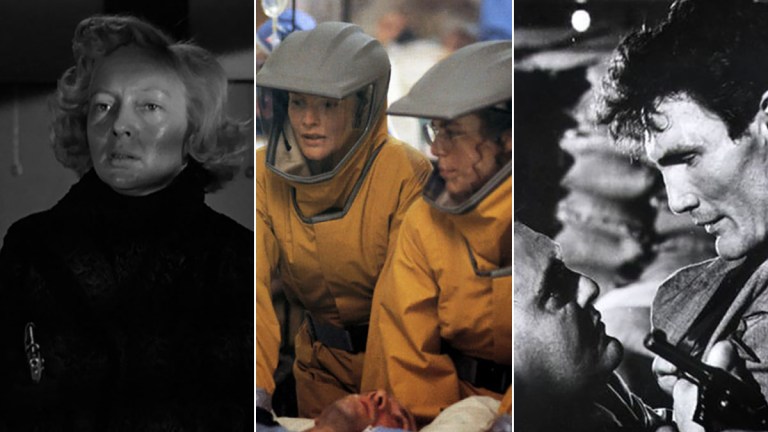The Origin of Outbreak Movies
As Coronavirus news dominates the headlines, we look back at where the Disease Movie subgenre comes from.

Beginning with The Andromeda Strain in 1971, disease movies quickly established themselves as a commonplace cinematic subgenre, usually within the science fiction umbrella. In the years that followed, we got the likes of Outbreak, Contagion, Virus, The Stand, 12 Monkeys, The Crazies, 28 Days Later, most post-Night of the Living Dead zombie movies, The Omega Man, Winds of Terror, and dozens of others.
It only made sense. Despite antibiotics and advances in medical research, new dread diseases continued to crop up on an annual basis, each one threatening (for a while there anyway) to become a pandemic that could wipe out millions. In recent decades, none of them had killed more than a few thousand people, but the threat and the fear were a constant presence. There was swine flu, various incarnations of bird flu, SARS, West Nile Virus, mad cow disease, Hantavirus ,superbugs, and Ebola. Add to that the threat of bioterror and the seemingly endless string of security breaches at bioresearch institutes, and it was only natural our media-fed paranoia would be reflected in popular big budget movies with all-star casts. Now with 2019 Novel Coronavirus (or COVID-19) shaping up to be a contagious deadly disease that could turn into a global pandemic, it seems as good a time as any to take a look back half-a-century when another threatening pandemic spawned the whole Disease Movie subgenre.
In March and April 1947, long before our contemporary germophobic paranoia took hold, there was a smallpox outbreak in New York that killed two people and infected 10 others, resulting in the largest mass smallpox inoculation in American history. It also led to a small but intriguing early outbreak of disease films.
The events actually began, however, in February when a rug salesman from Maine and his wife boarded a bus in Mexico City to return home after a vacation. Along the way, the salesman started feeling poorly, with a headache and neck pain. They got off the bus in New York and checked into a hotel. When the man further developed a rash and fever, he was brought to Bellevue hospital, and was then transferred to an infectious disease facility a few days later. He died within a week, without ever having been properly diagnosed.
Shortly after his body was removed, two more people who’d been patients at the same hospital began exhibiting symptoms. Only then were these cases finally confirmed to be smallpox. As still more cases began appearing both in the city and upstate, the New York Department of Health and the U.S. Public Health Service quickly made the connection and, understanding what they were up against, set about tracking down every last person the rug salesman had been in contact with. That meant everyone at the hotel, everyone on the bus, and everyone in both hospitals. It meant tracking down and vaccinating hundreds of people spread out over nearly 30 states.
Then, just to be on the safe side, in conjunction with the mayor’s office and the nation’s largest pharmaceutical companies, they launched a media blitz encouraging every last man, woman, and child in New York to get vaccinated, setting up free clinics all over the city. By the end of April, nearly 6.5 million New Yorkers had taken the needle, and the epidemic was declared over. The outbreak and the efforts to contain it were documented the following year in “The Killer That Stalked New York,” an article by Milton Lehman which appeared in Cosmopolitan magazine.
Although the rights to the article were snatched up by Columbia Pictures and the story handed to screenwriter Harry Essex, it’s quite likely the events in 1947 were also the primary inspiration for screenwriters Edna and Edward Anhalt over at 20th Century Fox, who, quite by coincidence, sketched out a story eerily similar to the one Essex was working on. As a result—and as would often become the case with Hollywood disaster movies—two different films at two different studios telling exactly the same story, more or less, unwittingly went into production at exactly the same time. And, as per usual, with history as a judge, one of the films would be remembered, the other relegated to a mere footnote.
Over at Columbia, Essex’s script stuck fairly close to the historical events, at least in terms of the Health Department’s reaction to the outbreak and the political scrambling between DOH, the mayor’s office, and several reluctant pharmaceutical companies. But knowing he needed a little more pizzazz and sex appeal to make a compelling, exciting crowd-pleaser out of the material at hand, Essex morphed Patient Zero from a middle-aged rug salesman into an attractive young blonde smuggling diamonds in from Cuba. He also tossed in a seedy love triangle, a couple cute kids, some tenements and flophouses, a little gunplay, and a few other standard noirish elements. The big, smart move on Essex part, however, was turning the good-hearted free clinic physician into a detective in a race against time. The opening narration does what it can to plant the film squarely in noir territory:
“Death didn’t sneak into town riding the rods or huddled in a boxcar, it came in on a streamliner, first class, extra fare, right into the Pennsylvania Station big as life. And when it finally stepped out of its drawing room onto the platform, it was something to whistle at. It wore lipstick, nylons, and a beautifully tailored coat sporting a silver dancing girl—souvenir of Cuba—and its name was Sheila Bennet. A pretty face with a frame to match worth following. And followed she was, by a big-faced man from the Treasury Department. A T-Man on the make. Not for what she was, but for what she’d done…”
As ham-fisted and silly as it is, at heart it’s a desperate plea to audiences to see the film as something more than an eighth-grade health movie writ large, which is what it feels like at times. Directed by Earl McEvoy, a longtime assistant director helming his second feature, The Killer That Stalked New York stiffly and sometimes clumsily follows two distinct storylines, which eventually come together. In one, Sheila Bennet (Evelyn Keyes) tries to evade Treasury agents after smuggling some diamonds in from Cuba, all in an attempt to reunite with her sleazy husband so the two of them can fence the ice and skip down to South America. Too bad for her her husband is plotting to ditch her for her younger sister.
In the other, good-hearted and earnest Dr. Ben Wood (William Bishop) tries to track down whoever is spreading smallpox all over the city and, failing that, attempts to arrange to get everyone in New York inoculated before it’s too late. Although the audience is told from the start, it takes him awhile to figure out he, too, is looking for Sheila Bennet.
What’s interesting here is that as the disease begins to spread, McEvoy pulls the camera back, showing the city in panorama as the panic grows. The two primary storylines are both swallowed and at times forgotten by the fear that takes hold of the entire city. It becomes an educational film as the narrator describes the government’s response to a major health crisis in painful detail. He only brings the camera back in close again toward the film’s end when Dr. Wood closes in on Sheila. For all its lo-fi, low-budget clunkiness (and some mighty awful narration), there is a simple, earnest charm to McEvoy’s movie, which among other things helped educate the public about the dangers lurking in public water fountains.
Meanwhile over at Fox, Richard Murphy’s screenplay (based on the Anhalts’ story), while still focused on a U.S. Public Health service doctor-turned-detective, pushed the noir elements to the forefront, and just to spice things up further changed the locale from New York to New Orleans and the disease in question from smallpox to plague.
Although there are whispers of smuggling in Panic in the Streets, nothing much comes of them. Instead the film opens with a couple thugs killing an immigrant fresh off a tramp steamer, suspecting him of playing sick to welch out of a card game. When the body is discovered, and further discovered to be carrying pneumonic plague, U.S. Public Health service doctor Clint Reed (Richard Widmark) is called in, and quickly, yes, turns detective.
His first order of business is to figure out the man’s identity, given he was carrying no papers. Once he knows that, then he’ll need to track down everyone who came in contact with him (including his killer), given they all might well have the plague too now. So with the help of a reluctant police captain (Paul Douglas), he begins making the rounds of all the handy noir locales: the docks, the tramp steamers, local Greek restaurants, bars and tenements. As the bodies start dropping, the search only becomes more frantic, with Dr. Reed vaccinating (or trying to anyway) anyone who might’ve even possibly had any contact with the swarthy little fellow.
Despite all the similarities between Panic in the Streets and Killer That Stalked New York, there are also a number of vast differences. In the second film, Killer’s two distinct storylines are combined into one, with the cops and health department working in tandem. Director Elia Kazan never pulls the camera back to reveal the growing public panic, simply because there never is a growing public panic.
Despite the ongoing pesterings of an antsy and frustrated newspaperman, Dr. Reed, for much of the film anyway, refuses to allow the story to come out, fearing it would nudge the killer (a terrifying Jack Palance in his acting debut) to make a run for it, spreading the plague even further. Instead Kazan remains tightly focused on the investigation, almost following it in real time, leaving the film more murder mystery than public service announcement. In the end, the messages of both films are the same: Your government is on the case, so rest easy—you’ll be just fine.
At some point, word of the dual productions leaked and the brass at Columbia, perhaps realizing Panic had a bigger budget, a top director, a taut script, and a couple of recognizable stars, while they were sitting on a decidedly low-budget B quickie that tended toward the didactic, they opted to hold Killer for six months. The hope was that this would be enough time for Panic to come and go, and for moviegoers to forget all about what was clearly the much better film.
Well, things didn’t exactly go as planned. Panic in the Streets came out in June 1950, and did not do terribly well at the box office, failing to earn back its budget. It did, however, go on to be considered a classic of the genre. Killer That Stalked New York was released in December of that same year, and was pretty well forgotten before it finished its run, much like everyone had forgotten about the smallpox outbreak it attempted to document.

